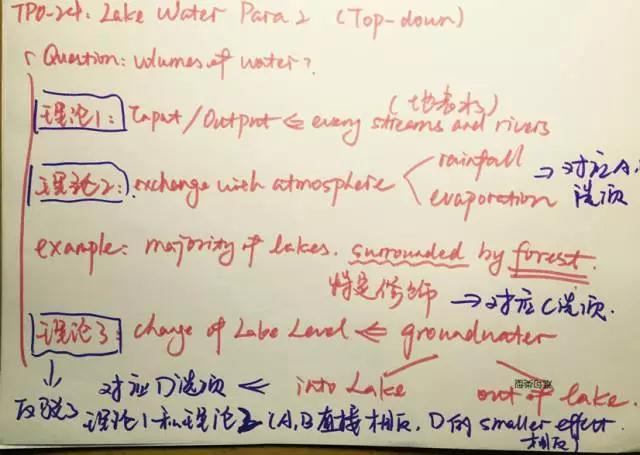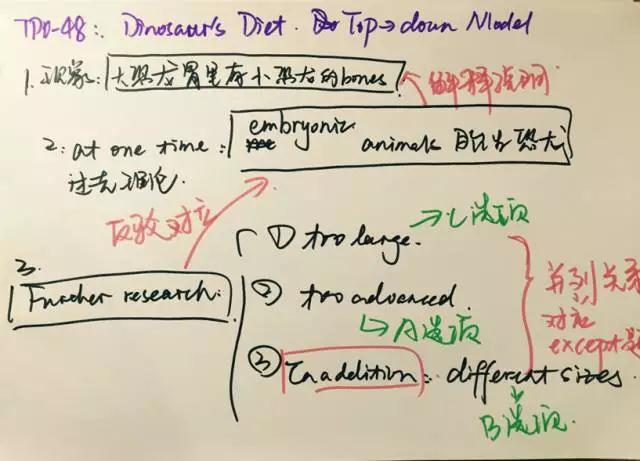

相信不少托福阅读老师在课后,都会让学生采用精读的方式去提升阅读质量,以此巩固学生阅读基础,同时加深作业的记忆和吸收程度。但往往学生对“精读”这个概念非常模糊,究竟怎么样才算是精读?是查出所有单词, 还是句句翻译,亦或者写解题思路?需不需要归纳段落大意?往往不同班型,不同基础的学生对于精读的理解也各不相同,这里就需要老师根据学生自身情况和文本难度,对学生有不同的精读要求。
为何需要分情况进行精读?
长久以来,不少学生在阅读中形成了习惯性的的共同认识: 阅读需要从单词和词组开始,也就是所谓的 “Bottom-up Model”——自下而上式的托福模式。学生对于托福阅读文本采取decoding解码的过程,先查出段落中的所有单词,然后逐步上升到短语、分句的解码翻译,最后落实句子、段落和语篇的理解;学生不断地对输入的托福阅读文本进行信息处理和整合,整个过程结束,阅读也就结束,随后才进行题目分析。
Bottom-up Model虽然是一种从基础→繁复的自然理解过程,但也将阅读过程简单化,忽略了托福阅读过程中的语境因素: 我们会发现,不少学生似乎能够全段都翻译下来,但基本上还是以词汇和语法为中心,采用分析语法结构的方法,理解重心完全放在了语言因素(词汇,语法,语句分析等),往往忽略了非语言因素的影响(句间逻辑,逻辑推理,作者目的,背景知识等)。这种Bottom-up的阅读模式虽然在教学初期可以采用,但由于精读过程非常繁琐冗长,且会让学生产生“只见树木不见树林”的阅读观感,对于程度较好的学生并不适用。
为了解决 “自下而上”的阅读模式所产生的问题,另一种阅读模式也就应运而生: Top-down的心理阅读模式。这种模式要求学生在阅读的过程中,能够act as a positive participant, 根据自己已有的句法,语法和语义知识,对于段落文本形成 Scanning→Predicting→Testing→Confirming→Revising 的五段加工模式;简而言之,就是学生要能从段落整体框架入手,确立文本展开模式,随后将句子,分句,词组和单词按照语法规则往框架内部做填充,进行信息甄别处理。
Top-down模式强调学生面临的阅读问题可能并不是语言问题,而是阅读技巧和逻辑思维问题,它也确实能解决Bottom-up模式中的“只见树木不见树林”的问题,但无疑也从一个极端走向另一个极端。托福阅读考试本就是语言考试,虽然存在像推理题、目的题、插入题这种考察句间逻辑和逻辑判断的题型,但重心依旧还是在语言的基本理解上;Top-down的精读模式强调的快速阅读,很容易让学生滥用结构框架进行预测,反而忽视了对于基础字句的理解 (造成细节题和取非题的错误),或者在predicting的过程中将自己的想法理解强加在选项上 (造成干扰选项判断错误)。
那既然无论是Bottom-up 还是 Top-down均有优势和劣势,那在我们的培训过程或者学生精读过程中,不妨根据学生实际情况进行要求,做到两者结合,即 “相互作用模式”:根据学生不同程度,或者文本的不同难度,选择不同的精读模式。既强调基本的字句理解,通过语言本身达到理解目的,又不要忽视段落结构和考点预判的模式,从整体角度分析难点题目。
那么根据以上的教学法模式论述,我们也可根据学生的不同基本或者文本的不同难度,对学生下达不同的精读要求:
1) 基础良好,阅读能力强的学生重点以Top-down阅读模式梳理锻炼框架,学会抓取思路考点和分析段落框架,并且能够从逻辑和内容的角度逐一甄别每个选项。
2) 基础尚可,阅读能力在20分左右,词汇基础足够的同学可以采取Top-down & Bottom-up结合的模式,在基本理解段落构成之外,重点放在难句翻译理解,明确题目考点和选项逐一排除上。
3) 基础薄弱,尤其是阅读成绩个位数或者10分出头的学生,应采取Bottom-up的模式进行精读:原文段落题干选项逐一摘词背诵,段落逐句分析翻译,题目对应区间定位。
Bottom-up Model阅读模式在托福阅读中基本就是查词+词性辨析+句法分析+段落逐句翻译,这边不再赘述~
对于Top-down的阅读模式举几个栗子:
TPO-24: Lake Water
Paragraph 2: The questions become more complicated when actual volumes of water are considered: how much water enters and leaves by each route? Discovering the inputs and outputs of rivers is a matter of measuring the discharges of every inflowing and outflowing stream and river. Then exchanges with the atmosphere are calculated by finding the difference between the gains from rain, as measured (rather roughly) by rain gauges, and the losses by evaporation, measured with models that correct for the other sources of water loss. For the majority of lakes, certainly those surrounded by forests, input from overland flow is too small to have a noticeable effect.Changes in lake level not explained by river flows plus exchanges with the atmosphere must be due to the net difference between what seeps into the lake from the groundwater and what leaks into the groundwater. Note the word"net": measuring the actual amounts of groundwater seepage into the lake and out of the lake is a much more complicated matter than merely inferring their difference.
3. Which of the following can beinferred from paragraph 2 about the movement of water into a lake?
A. Heavy rain accounts for most of the water that enters into lakes.
B. Rainfall replaces approximately the amount of water lost through evaporation.
C. Overland flow into lakes is reduced by the presence of forests.
D. Seepage has a smaller effect on water level than any other input.
Top-down Model: Paragraph structure 精读要求
1). Question about Lake level
2). Theory 1: 地表水(flowing of inflowing and outflowing river and stream) →决定了Lake level
3). Theory2: 大气层交换(difference between rainfall and evaporation ) →决定了Lake Level
4). Example:majority of lake, especially surrounded by forest (特指修饰→可能会有考点)
5). Theory3: 反驳 (not explained by river flows plus atmosphere →间接反驳了theory 1 and 2) + 正确观点地下水的渗透(difference between seepage into the lake and seepage into the groundwater)
6). “Net” emphasis~
段落结构Top-down图如下:

题目分析: 审题(movement of water into a lake)题干中无关键词,放弃定位
段落提出了三个理论来解释湖水水面的改变,分别是地表水流动,大气层交换和地下水渗透,而最终支持的理论是地下水渗透造成lake level的改变,可以排除D选项 (smaller effect直接相反);同样大气层交换的理论被驳斥了,则可以排除A和B选项 (Heavy rain accounts for相反;rainfall replaces approximately未提到且不能解释changes of lake level);我们发现,通过分析段落框架,就足以让我们排除A, B, D三个选项。
原文的example部分提到了多数的lake,尤其“被森林包围的”湖,地表水的流动几乎可以忽略不计。Surrounded by forest作为限定修饰,必然起到了强调的作用,突出了”整体与部分”概念,既然多数的湖本身不会受到overland flow的影响,那部分的“被森林包围的湖”就强调出 “forests have negative effect on Lake level”,就如同我们说: 吃油炸食品,尤其是鸡排,肯定会造成肥胖,那也可以间接得出鸡排会造成肥胖,是一样的思路, 故此题的答案也自然可以得出C选项
对于程度较好的学生而言,做对题目本身并不意味这结束,能够学会运用Top-down的阅读模式,掌握在实际阅读和后期精读中完成对于段落结构的梳理,明细结构下的考点对应和字句理解,才是真正提高阅读质量,有效利用TPO进行托福备考~
最后我们再看一个段落,看看各位能否以Top-down的阅读模式梳理出段落框架,再合理进行字句理解和考点对应
TPO-48: Determining Dinosaurs’ Diet
Paragraph 5: In the stomach contents of specimens of Coelophysis (a small, long-necked dinosaur) are bones from juvenile animals of the same species. At one time, these were thought to represent embryonic animals, suggesting that this small dinosaur gave birth to live young rather than laying eggs. Further research indicated that the small dinosaurs were too large and too well developed to be pre-hatchling young. In addition, the juveniles inside the body cavity were of different sizes. All the evidence points to the conclusion that these are the remains of prey items and that, asan adult, Coelophysis was at least in part a cannibal.
• 7. According to paragraph 5, all of the following support the claim that the adult Coelophysis sometimes ate young Coelophysis EXCEPT:
A. Juveniles found in the body cavities of adults were too advanced in their development to be embryos.
B. Juveniles of different sizes were found in the body cavity of the same adult.
C. Juveniles found in the body cavities of adults were too large to be embryos.
D. Juveniles found in the body cavities of adults were in unhatched eggs.

最新热文推荐:
(实习编辑:莫颖)
 选择城市
选择城市